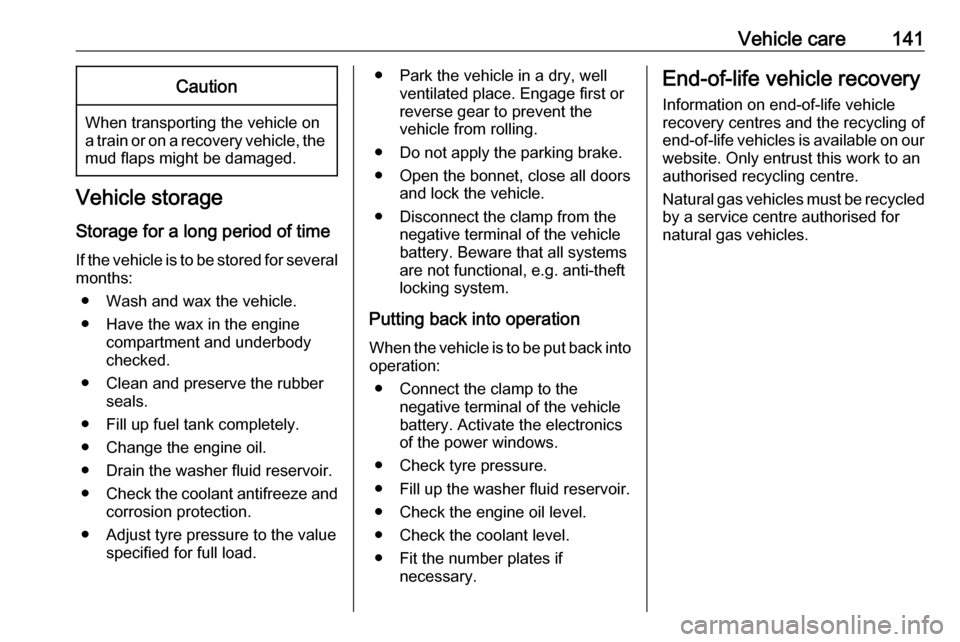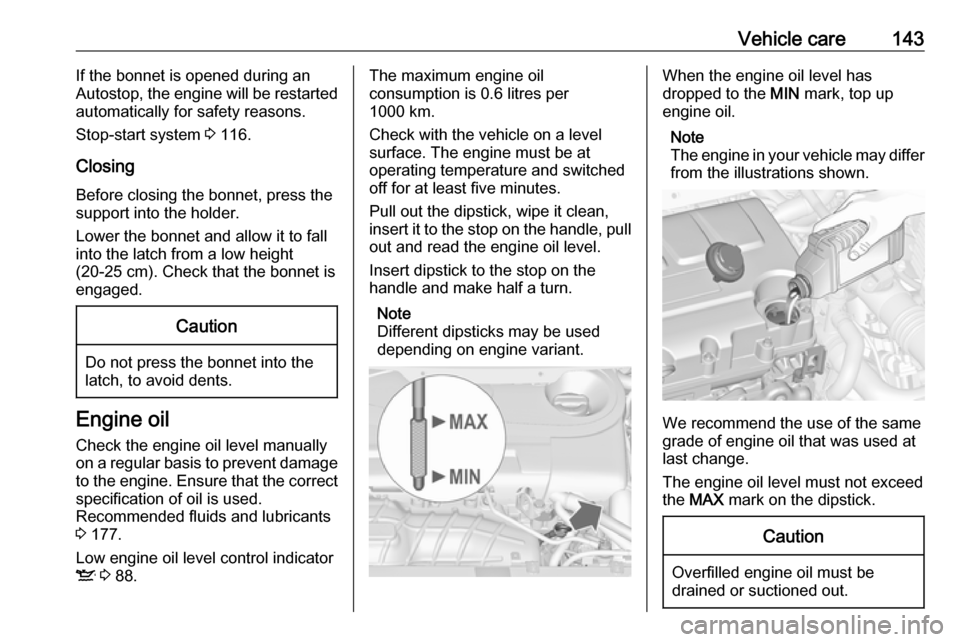bonnet OPEL COMBO D 2017.5 Manual user
[x] Cancel search | Manufacturer: OPEL, Model Year: 2017.5, Model line: COMBO D, Model: OPEL COMBO D 2017.5Pages: 201, PDF Size: 4.76 MB
Page 13 of 201

In brief111Fixed air vents ..................... 111
2 Side air vents ...................... 110
3 Light switch .......................... 99
High beam, low beam ...........99
Headlight flash ......................99
Daytime running lights ........100
Turn and lane-change
signals ................................. 101
4 Instruments ........................... 76
Driver Information Centre ...... 90
5 Windscreen wiper/washer .....71
Rear window wiper/washer ..71
Headlamp washer .................72
Trip odometer reset ............... 76
6 Centre air vents .................. 110
7 Document holder, pocket
for Personal Navigation
Device .................................. 60
8 Headlight range
adjustment ......................... 100
Driver Information Centre
controls ................................ 90Trip computer........................ 96
Instrument illumination ........102
Hazard warning flashers .....100
Front fog lights ...................101
Rear fog light ...................... 101 Heated rear window ..............34
Heated exterior mirrors .........31
Clock ..................................... 72
Airbag deactivation ...............53
9 Front passenger airbag ........52
10 Glovebox .............................. 61
11 Heating and ventilation
system ................................. 106
Air conditioning system .......107
Electronic climate control
system ................................. 108
12 Selector lever, manual
transmission ....................... 121
Manual transmission
automated ........................... 122
13 Ignition switch with
steering wheel lock ............11414Steering wheel controls .......70
15 Horn ..................................... 70
Driver airbag ........................ 52
16 Steering wheel adjustment ..70
17 Cruise control .....................130
18 Fuse box ............................. 156
19 Bonnet release lever ..........142
Page 92 of 201

90Instruments and controlsFog light> illuminates green.
The front fog lights are on 3 101.
Rear fog light ø illuminates yellow.
The rear fog light is on 3 101.
Cruise control
m illuminates green.
The system is switched on.
Depending on version, a
corresponding message, e.g. Cruise
Control on , may also be displayed in
the Driver Information Centre 3 90.
Cruise control 3 130.
Door open
( illuminates red.
Illuminates when a door, the bonnet
or the tailgate is open.
Depending on version, a warning
message may also be displayed in
the Driver Information Centre 3 90.When the vehicle starts to move, a
warning chime also sounds.Information displays
Driver Information Centre The Driver Information Centre is
located in the instrument cluster
between the speedometer and
tachometer. Two versions are
available.
Standard version is shown in the
illustration above.
Page 97 of 201

Instruments and controls95Passenger bag or Passenger airbag
(Passenger front and side airbags
activation/deactivation)
Activate the front passenger airbags if an adult is occupying the front
passenger seat. Deactivate airbags
when a child restraint system is
installed on this seat.9 Danger
Risk of fatal injury for a child using
a child restraint system on a seat
with activated front passenger
airbag.
Risk of fatal injury for an adult
person on a seat with deactivated
front passenger airbag.
After accessing this menu option,
activate or deactivate the airbags
( Bag Pass On or Bag Pass Off ) and
confirm; a confirmation message
appears in the display. Select YES (to
confirm changes) or No (to cancel
changes).
Airbag deactivation 3 53.
Day lights or Daytime running lights
Activate the daytime running lights to
increase visibility of the vehicle during
daylight (set to On). Deactivate when
not required (set to Off).
Daytime running lights 3 100.
Exit Menu
Select this menu option to exit the
settings menu.Vehicle messages
Warning chimesOnly one warning chime will sound at
a time.
The warning chime regarding
unfastened seat belts has priority
over any other warning chime.
When starting the engine or whilst driving
● If seat belt is not fastened.
● If a certain speed is exceeded with the parking brake applied.
● If the parking assist detects an object.
● If a fault is detected in the parking
assist.
● If a door, the bonnet or the tailgate is not fully closed when
starting-off.
● If the vehicle speed briefly exceeds a set limit.
● If the stop-start system cannot restart the engine automatically.
Page 119 of 201

Driving and operating117Deactivation
Deactivate the stop-start system
manually by pressing ^ in the centre
console. LED in the button illuminates
to confirm deactivation.
Depending on version, a
corresponding message, e.g.
Start&Stop disconnected , may also
be displayed in the Driver Information
Centre 3 90.
Autostop
If the vehicle is at a low speed or at a standstill, activate an Autostop as
follows:
● depress the clutch pedal
● set the lever to neutral
● release the clutch pedal
The engine will be switched off while the ignition stays on.
An Autostop is indicated when control
indicator ^ flashes in the Driver
Information Centre 3 90.
During an Autostop, the heating,
power steering and brake
performance will be maintained.
Caution
The power steering assist may be
reduced during an Autostop.
Conditions for an Autostop
The stop-start system checks if each
of the following conditions is fulfilled.
Otherwise an Autostop will be
inhibited.
● the stop-start system is not manually deactivated
● the bonnet is fully closed
● the driver's door is closed and the
driver's seat belt is fastened
● the vehicle battery is sufficiently charged and in good condition
● the engine is warmed up
● the engine coolant temperature is
not too high
● the engine exhaust temperature is not too high, e.g. after driving
with high engine load
● the ambient temperature is not too low
● the climate control system allows
an Autostop
Page 142 of 201

140Vehicle careVehicle careGeneral Information...................140
Accessories and vehicle modifications .......................... 140
Vehicle storage ........................141
End-of-life vehicle recovery .....141
Vehicle checks ........................... 142
Performing work ......................142
Bonnet ..................................... 142
Engine oil ................................. 143
Engine coolant ......................... 144
Power steering fluid .................144
Washer fluid ............................ 145
Brakes ..................................... 145
Brake fluid ............................... 145
Vehicle battery ......................... 146
Wiper blade replacement ........147
Bulb replacement .......................148
Halogen headlights ..................148
Fog lights ................................. 150
Tail lights ................................. 150
Side turn signal lights ..............151
Centre high-mounted brake light ......................................... 151
Number plate light ...................152Interior lights ............................ 153
Instrument panel illumination ...154
Electrical system ........................154
Fuses ....................................... 154
Engine compartment fuse box . 155
Instrument panel fuse box .......156
Vehicle tools .............................. 158
Tools ........................................ 158
Wheels and tyres .......................159
Winter tyres ............................. 159
Tyre designations ....................159
Tyre pressure .......................... 159
Tyre pressure monitoring
system .................................... 160
Tread depth ............................. 162
Changing tyre and wheel size . 162 Wheel covers ........................... 162
Tyre chains .............................. 163
Tyre repair kit .......................... 163
Wheel changing .......................165
Spare wheel ............................ 167
Jump starting ............................. 169
Towing ....................................... 171
Towing the vehicle ...................171
Towing another vehicle ...........172
Appearance care .......................172
Exterior care ............................ 172
Interior care ............................. 175General Information
Accessories and vehiclemodifications
We recommend the use of genuine
parts and accessories and factory
approved parts specific for your
vehicle type. We cannot assess or guarantee reliability of other products
- even if they have a regulatory or
otherwise granted approval.
Any modification, conversion or other
changes made to standard vehicle
specifications (including, without
limitation, software modifications,
modifications of the electronic control units) may invalidate the warrantyoffered by Opel. Furthermore, such
changes may impact fuel
consumption, CO 2 emissions and
other emissions of the vehicle and
cause the vehicle to no longer
conform to the type approval,
impacting the validity of your vehicle
registration.
Page 143 of 201

Vehicle care141Caution
When transporting the vehicle on
a train or on a recovery vehicle, the
mud flaps might be damaged.
Vehicle storage
Storage for a long period of time
If the vehicle is to be stored for several months:
● Wash and wax the vehicle.
● Have the wax in the engine compartment and underbody
checked.
● Clean and preserve the rubber seals.
● Fill up fuel tank completely.
● Change the engine oil.
● Drain the washer fluid reservoir.
● Check the coolant antifreeze and
corrosion protection.
● Adjust tyre pressure to the value specified for full load.
● Park the vehicle in a dry, wellventilated place. Engage first or
reverse gear to prevent the
vehicle from rolling.
● Do not apply the parking brake.
● Open the bonnet, close all doors and lock the vehicle.
● Disconnect the clamp from the negative terminal of the vehicle
battery. Beware that all systems
are not functional, e.g. anti-theft
locking system.
Putting back into operation
When the vehicle is to be put back into operation:
● Connect the clamp to the negative terminal of the vehicle
battery. Activate the electronics
of the power windows.
● Check tyre pressure.
● Fill up the washer fluid reservoir.
● Check the engine oil level.
● Check the coolant level.
● Fit the number plates if necessary.End-of-life vehicle recovery
Information on end-of-life vehicle
recovery centres and the recycling of
end-of-life vehicles is available on our website. Only entrust this work to an
authorised recycling centre.
Natural gas vehicles must be recycled by a service centre authorised for
natural gas vehicles.
Page 144 of 201

142Vehicle careVehicle checks
Performing work9 Warning
Only perform engine compartment
checks when the ignition is off.
The cooling fan may start
operating even if the ignition is off.
9 Danger
The ignition system uses
extremely high voltage. Do not
touch.
Bonnet
Opening
Pull the release lever (located on the
lower left side of the instrument panel) and return it to its original position.
Move the safety catch sideways and
open the bonnet.
Secure the bonnet support.
Page 145 of 201

Vehicle care143If the bonnet is opened during an
Autostop, the engine will be restarted
automatically for safety reasons.
Stop-start system 3 116.
Closing Before closing the bonnet, press the
support into the holder.
Lower the bonnet and allow it to fall
into the latch from a low height
(20-25 cm). Check that the bonnet is
engaged.Caution
Do not press the bonnet into the
latch, to avoid dents.
Engine oil
Check the engine oil level manually
on a regular basis to prevent damage
to the engine. Ensure that the correct specification of oil is used.
Recommended fluids and lubricants
3 177.
Low engine oil level control indicator
S 3 88.
The maximum engine oil
consumption is 0.6 litres per
1000 km.
Check with the vehicle on a level
surface. The engine must be at
operating temperature and switched
off for at least five minutes.
Pull out the dipstick, wipe it clean,
insert it to the stop on the handle, pull
out and read the engine oil level.
Insert dipstick to the stop on the
handle and make half a turn.
Note
Different dipsticks may be used
depending on engine variant.When the engine oil level has
dropped to the MIN mark, top up
engine oil.
Note
The engine in your vehicle may differ from the illustrations shown.
We recommend the use of the same
grade of engine oil that was used at
last change.
The engine oil level must not exceed
the MAX mark on the dipstick.
Caution
Overfilled engine oil must be
drained or suctioned out.
Page 175 of 201

Vehicle care173If using a vehicle wash, comply with
the vehicle wash manufacturer's
instructions. The windscreen wiper and rear window wiper must be
switched off. Remove antenna and
external accessories such as roof
racks etc.
If you wash your vehicle by hand,
make sure that the insides of the
wheel housings are also thoroughly
rinsed out.
Clean edges and folds on opened
doors and the bonnet as well as the
areas they cover.
Clean bright metal mouldings with a
cleaning solution approved for
aluminium to avoid damages.Caution
Always use a cleaning agent with
a pH value of four to nine.
Do not use cleaning agents on hot surfaces.
Have the door hinges of all doors
greased by a workshop.
Do not clean the engine compartment with a steam-jet or high-pressure jet
cleaner.
Thoroughly rinse and leather-off the vehicle. Rinse leather frequently. Use
separate leathers for painted and
glass surfaces: remnants of wax on
the windows will impair vision.
Do not use hard objects to remove
spots of tar. Use tar removal spray on
painted surfaces.
Exterior lights
Headlight and other light covers are
made of plastic. Do not use any
abrasive or caustic agents, do not use an ice scraper, and do not clean them
dry.
Polishing and waxing
Wax the vehicle regularly (at the
latest when water no longer beads).
Otherwise, the paintwork will dry out.
Polishing is necessary only if the paint
has become dull or if solid deposits
have become attached to it.Paintwork polish with silicone forms a
protective film, making waxing
unnecessary.
Unpainted plastic body parts must not be treated with wax or polishing
agents.
Matt filmed body parts or decor tapes must not be polished, to avoid
gleaming. Do not use hot wax
programmes in automatic car washes if the vehicle is equipped with theseparts.
Matt painted decor parts, e.g. mirror
housing cover, must not be polished.
Otherwise these parts would become
agleam or the colour would be
dissolved.
Windows and windscreen wiper
blades
Use a soft lint-free cloth or chamois
leather together with window cleaner and insect remover.
When cleaning the rear window from
inside, always wipe in parallel to the
heating element to prevent damage.
Page 196 of 201

194IndexAAccessories and vehicle modifications .......................... 140
Adjustable air vents ...................110
Airbag activation ........................... 90
Airbag and belt tensioners ...........82
Airbag deactivation ..........53, 83, 90
Airbag label............................. 48, 53
Airbag system .............................. 48
Air conditioning regular operation ................................ 111
Air conditioning system .............. 107
Air intake .................................... 111
Air vents...................................... 110
Alert .............................................. 95
Antilock brake system ................ 126
Antilock brake system (ABS) .......84
Anti-Slip Regulator (ASR) ...........128
Anti-theft locking system .............. 29
Appearance care ........................172
Armrest ......................................... 40
Ashtrays ....................................... 75
ASR (Anti-Slip Regulator) ...........128
Audible warning chimes................ 95
Autoclose ...................................... 90
Automatic fuel cut-off ............96, 115
Automatic locking .........................90
Autostop ..................................... 116
AUX socket ................................... 74B
Battery ........................................ 146
Battery discharge protection ......105
Belts.............................................. 45
Bonnet ....................................... 142
Brake and clutch fluid .................177
Brake assist ............................... 127
Brake fluid .................................. 145
Brake pad wear ............................ 84
Brakes ............................... 126, 145
Brake system ............................... 84
Breakdown.................................. 171
Bulb replacement ....................... 148
C Capacities .................................. 189
Car Pass ...................................... 21
Catalytic converter .....................120
Central locking system ................24
Centre high-mounted brake light 151
Change engine oil .......................88
Changing tyre and wheel size ...162
Charging system .......................... 83
Child locks ................................... 25
Child restraint installation locations ................................... 57
Child restraints.............................. 55
Child restraint systems ................55
Child safety system for rear windows .................................... 32